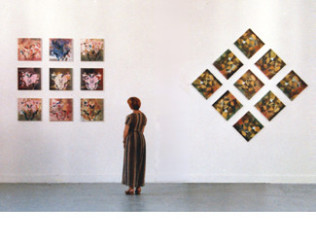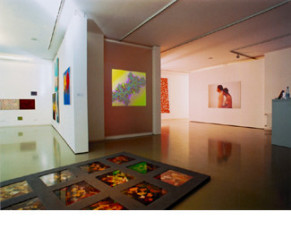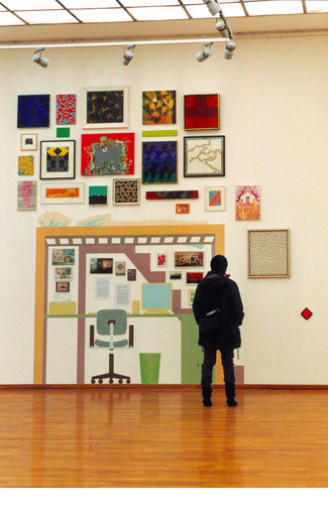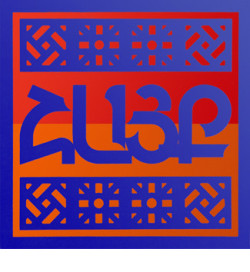Archi Galentz
born 1971 in Moskau, lives and works in Berlin
Languages
German, Russian, English, Armenian
http://www.interiordasein.de/de/archi-galentz-atelier
archigalentz@genion.de
In the work of Archi Galentz it is the tragic plight of the Armenian nation which is evoked and which has very often been perceived as one of the thresholds of empathy. How can one imagine oneself in the midst of genocide? How does one relate nowadays to the evident lack of interest in the outcomes of the Armenian tragedy, as opposed to more general public duties of feeling for what happened to Jews in WW2 or to Kosovo Albanians more recently? There is no way to compare, measure or verify that one and the same emotion applies to all historical examples of genocide, or the experience of exile as the platform for recollection/reflection: today almost three quarters of Armenians live outside their historical territories. Archi Galentz collects works by Armenian artists in his small Berlin apartment. Yet, it is not an ethnographic collection as one may be lead to assume, it is an art collection, maybe not one that fits established contemporary aesthetic standards (although no one would dare to identify something like that now), but certainly one that shows some private act of being-with. Galentz´s famous historical compatriot, Arshile Gorky, avoided the word 'influence' when he wanted to describe the effect that different 'sources' have on his work, and which may range from 'the lacework of Khatchkar' to heroes of Modern art. Instead he spoke of 'being with' someone, dead or alive, Thoros Roslin or Pablo Picasso: the notion of 'being with' indicates a complex process of mutual 'impregnating' of the self and the other. Galentz shows his collection in art institutions, together with other markers of his private space, such as a bed or a door. It is no longer his 'art', the product of his 'encumbered' self, which is on display, but the setting of his 'situated self'. It is a situation in which certain things develop a special meaning for him and relate to his own mental states. But the 'thingness' of works exhibited in his private space, their 'not-I' presence, does not illustrate some identity-craving: 'who I am' is less important then where I am standing.
An extract from Attentive observations, situated motivations and displaced inquiries. Situated Self Exhibition catalogue text.
By Branislav Dimitrijevich.2005
Curriculum Vitae
1971 born in Moscow
1988 A-level in Moscow
1989 State University of Arts and Theater in Yerevan, Armenia
1992 Study at Acadamy of Arts (HdK Berlin) classes of Prof. Hirsig and Prof. Fußmann, Berlin
1996 Graduate of HdK.1997 Masterclass Diploma Degree at Prof. Fußmann.
1998 Work at Collegium of Art Restorers Berlin
1999 First Part of Final Exams in Design at HdK Berlin
2000 Works as freelance artist in Berlin, Moscow and Yerevan
2003 Writes for mass media
2004 Teaches
2008 Runs an exhibition space in Berlin-Wedding
2009 Stiftungsmitglied der "Galentz Kulturstiftung", Jerewan, Armenien
2010 Gestaltung des Künstleralmanach Nr24 "Berlin – Offene Stadt"
Selected Solo Show
2005 „The Red November" Frühstücksbühne, Eckernförde, Germany„This Days in 16 Years", Prima Center, Berlin
2004 „ArWest 33“, Atelier Kaiser-Friedrich Str.28, Berlin
2004 „Absolute Borders", With J. Balov at the „Berliner Liste" art fair, Berlin
2001 „Im Schwarzen Garden“, „Südost Zentrum“, Berlin
2000 „Archi Galentz, Malerei“ Gallery „Taube“, Berlin
Selected Group Show
2011 "Atlantis 2011", Palazzo Zenobio, 54tn Venice Biennial
"Manana Lesko - Moskauer Briefwechsel", Direktorenhaus, Berlin
2010 "10.Internationale Biennale von Miniaturen", Gornji Milanovac, Serbien
2009 "Voulu/Oblige", Forte Marghera, 53th Venice Biennial, Venedig.
"Enduring Futurism" Dispari & Dispary Project, Reggio Emilia
"ThisPLACEd: virtual, real, in between" City Gallery, Tallinn
2008 "A(r)mar Armenia", Asociacion Cultural Armenia, Buenos Aires
"Diagnosis / Interdiagnosis" Künstlerhaus, Jerewan, Armenien
2007 "Grand bleu", Galerie Artcor, Paris"under_construction : visual dialogue" Isola di San Lazzaro, Venedig
2006 "Grenz(über)bindung", Galerie Klinger, Görlitz
"Easy Transport" Museum für Zeitgenössisches Kunst, Skopje, Mazedonien
2005 "Focus Istanbul: Urbane Realitäten" Martin-Gropius Bau,
2005 "Situated Self" Museum of Contemporary Art, Belgrade, Serbia and Montenegro and Tennis Palace Art Museum, Helsinki, Finnland
"Requiem For The Genocide", Artists Haus, Yerevan
"Ego, International Festival", Museum of Contemporary Art, Medellin, Columbia
"Focus Istanbul: Urban Realities" Martin-Gropius-Bau, Berlin
"INTERNATIONAL", NCCA, Moscow
2004 "Armenian Linking", Prima Center, Berlin
"Not In The Sky and Not On The Earth" Museum of Contemporary Art, Skopje, Macedonia
"Na Kyrort, Russian Art Today", Staatliche Kunsthalle, Baden-Baden, Germany
2003 "Flowers from no man`s land", Gallery in Parlament, Abgeordnetenhaus, Berlin
"Paradies", M°A°I°S 2003, Bunker Alexanderplatz, Berlin
"Getting Closer. Four Armenians looking for a way out." ifa Gallery, Berlin and Bonn
2002 "Ostensiv", CAH Art Moscow, Moscow
"Childrens Fears", Zverjevskij Center, Moscow
"Nativ Land - Fatherland", Malij Manej, Moscow
"Stop! Who Is Coming?", NCCA, Moscow
2001 "Der Tod" M°A°I°S 2001, Bunker Gesundbrunnen, Berlin
"Artbunker in Moskau" CAH, Moscow
2000 "EXPO- 2000" Armenian Pavillon, Hannover
"Second International Gümri Biennale", Gymri, Armenia
"Kulturkreuzer Potjomkin" Festival of Young Russian Culture, Berlin
1998 "25 Jahre Gallery Taube" Gallery "Taube", Berlin
1996 "Art Students from Berlin" Gallery "Vasa", Falun, Sweden
1995 "Bernau 111, Armenian Graphic", Berlin
1989 "Student Posters" Museum of National Art, Sardarabad, Armenia
Selected Public Collections
Explanation of the Pictures on the Left. Archi Galentz:
Dear Silvina, dear all,
I send you hereby 4 works as requested. I also send you an extract from the catalogue "Situated Self" by Branislav Dimitrijevich. I started a long letter referring to the topics you asked for in
"Project Proposal" like - is it possible today to be Armenian in a diaspora frame,- which ways are binding us to another,- is it possible to reexperience a feeling of nationhood through virtual
communication,those are very important topics but I think that in the beginning it is more important to get to know each others work.The 4 pictures, on the other hand, don't mean much without
explanations so I will try explaining the chosen examples of my work as they mostly treat similar problems as formulated in your proposal.
1) - First picture "Hajk" 1994
This is an Armenian coat of arms developed in Berlin. The project begins in 1991 in Yerevan while studying art and design at the University of Yerevan art college. In the first year of Armenian
independence the government announced a competition to design a new coat of arms. This also became a task for students at the art college. Between 1991 and 1992 I made a series of sketches trying to
combine heraldic signs such as cross stones, eagles, the Ararat mountain and so on. The idea was to produce a notion of a country with own traditions symbolised by cross stones and the eagle with
spreaded wings, meant to be the protector of traditions and so on. I spent more time than foreseen on educational purposes but the professor wasn't really interested in the outcome and didn't want to
discuss the argumentations. Nowadays I see that this was a more or less typical situation of the intellectual situation in Armenia at that time as well as it is now. The professor who later became
the director of the Armenian artist association stated that according to him it was not the artist's task to devise state symbols. It should the politicians` task to exactly commission what they
wanted to be painted as they should also take responsibility for example if Turkey gets angry about a representation of the Ararat mountain on their territory on our coat of arms. Sometimes
later, having moved to Berlin, and getting acquainted to different points of view about an artist's role in society I continued to develop more or less for myself the idea of a symbolic
representation of Armenia. I decided to give up all militaristic heraldry and thought more about a problem of representing a nation to the outside world than trying to find a corresponding picture of
the inner political trend. In the new emblem I took the three national Armenian colours and wrote in Armenian HAJK as I found it very positive that Armenians have their own language and alphabet. To
me HAJK means the whole Armenian population and not the concrete geography. Also, Hajk is the name of the legendary founder of the Armenian nation and symbolises tradition. In simple words, I tried
to represent Armenians through cultural identity. In 1995 I used the Hajk writing for the 80th anniversary of the genocide remembrance day.
2 - The second photo shows a part of my master class exam exhibition in Berlin in 1997.
For more than two years I had worked on a series of litho prints deriving from the same litho stone showing an old map - a small place near Berlin in 1887 - from the time of the Berlin Congress
which can be seen as the beginning of the Armenian genocide. In all, I made nearly 60 prints - monotypes - and in different series. The first one was "Lost Paradise". These works were printed on
paper and plastic. I brought different types of earth from Armenia and made colour from them. At that time I thought a lot about Armenian identity, I even started reading in Armenian. The second
series was named "Byzanz". After that came "The 30 year war" and "The Black Garden". The last prints were blue starry skies. All these maps were not illustrating something special. I liked the
technique, not for multiplication purposes, but used it to create lots of layers. The abstract character of the maps makes them more or less timeless and allows to discuss different topics according
to the project context. On the picture are shown the series "Byzanz" an "The Black Garden". I displayed parts of this project in different exhibitions. This year "Lost Paradise" was chosen by
curators for the exhibition "Focus Istanbul".
3 - I tried to use the experience from the ifa project to make some further projects in other countries. I started contacting different Armenian artists, gathered material and examples of their art
works, tried to analyse terms and conditions of possible funding means and looked for an organisation interested in contemporary art to cooperate with. Together with fellow artists we tried to use
the fact of our being scattered in the world as a chance to present each other in a local contemporary art institution and to sensibilise the local Armenian communities to support a big art project
representing contemporary Armenian art. We focused on metropolises like Moscow, Yerevan, Paris, Los Angeles, Buenos Aires. This work is in progress but in the meantime I have come to understand that
we as a nation lack the fundamental structures in supporting our contemporary Armenian art. I also was disappointed by the structure of international contemporary art mechanisms taking advantage of
artists for their proper goals.
4 - The fourth picture shows a photo I took at the exhibition "Getting Closer - four Armenians are looking for a way out" in Berlin's ifa gallery in 2003. The works of four artists went on
display - Achot Achot, Kara and Narek. I took also part. The picture's front shows my maps laid out as a carpet. I consider this exhibition a very good example of cooperation between the
participating artists. It was me who proposed this project to the gallery, a non-profit organisation funded by the German Foreign Office. Its preparation took some two years, two curators travelled
to Armenia, a good catalogue was printed, all artists were invited to Germany, a transport of the art works was organised and paid for - an exhibition under ideal conditions. The working title was
"Four artists living in three different countries from two generations belonging to one circle". All artists knew each other, worked or exhibited together in the early nineties and thanks to the ifa
gallery they got a chance to exhibit together after ten years. This exhibition was also shown in the ifa gallery in the city of Bonn and to me it is a very good example of how much one can achieve by
being part of a group or involved in the representation of a cultural landscape. This gallery also made me acquainted with another Armenian artist living in Berlin, Silvina Der-Meguerditchjan, who
one day was invited to show her work in the course of the exhibition.
That's the reason why when being invited to the exhibition "Not on earth and not in heaven" organised by the Macedonian museum of contemporary art in Skopje in spring 2004, showing artists of
different origins living in Berlin, I used the possibility to be represented in a museum space not for my own art works but for the art pieces of the Armenian artists I had in my Berlin atelier. I
also built an artificial wall and presented the collection on both walls: the orange-painted private wall built especially for the paintings and the huge museum wall that doesn't look particularly
friendly for medium-sized pieces. I tried to compare which wall works out better for art works - museum space versus private space. I also wrote a statement shown on the wall in the Skopje museum.
Back in Berlin I made the curator of our Berlin exhibition acquainted with the material and he invited me participate in the exhibition named "Situated Self" he was involved in. This exhibition took
part this year in Belgrade's museum of modern art and in Helsinki's city museum of art. The same statement as in Skopje and a photo showing my bed wall with the art collection in Berlin was printed
in the catalogue. Enclosed you'll find this statement. As you can see in the picture I used the museum wall in Belgrade again to imitate a private space. I painted my bed schematically on the wall
and put the originals over it. Underneath the bed I presented a statement and some photos of former exhibitions.






